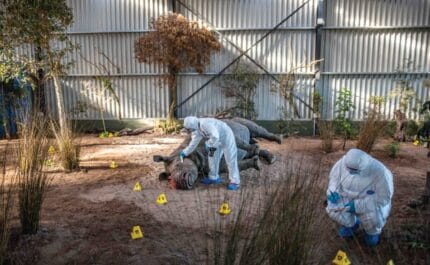“We’re pushing into the unknown”
Launched into space on Christmas Day, the James Webb Space Telescope is one of the greatest scientific endeavours of the century so far. Mark Clampin of Nasa’s Sciences and Exploration Directorate has been with the project throughout and tells us how this extraordinary feat was achieved
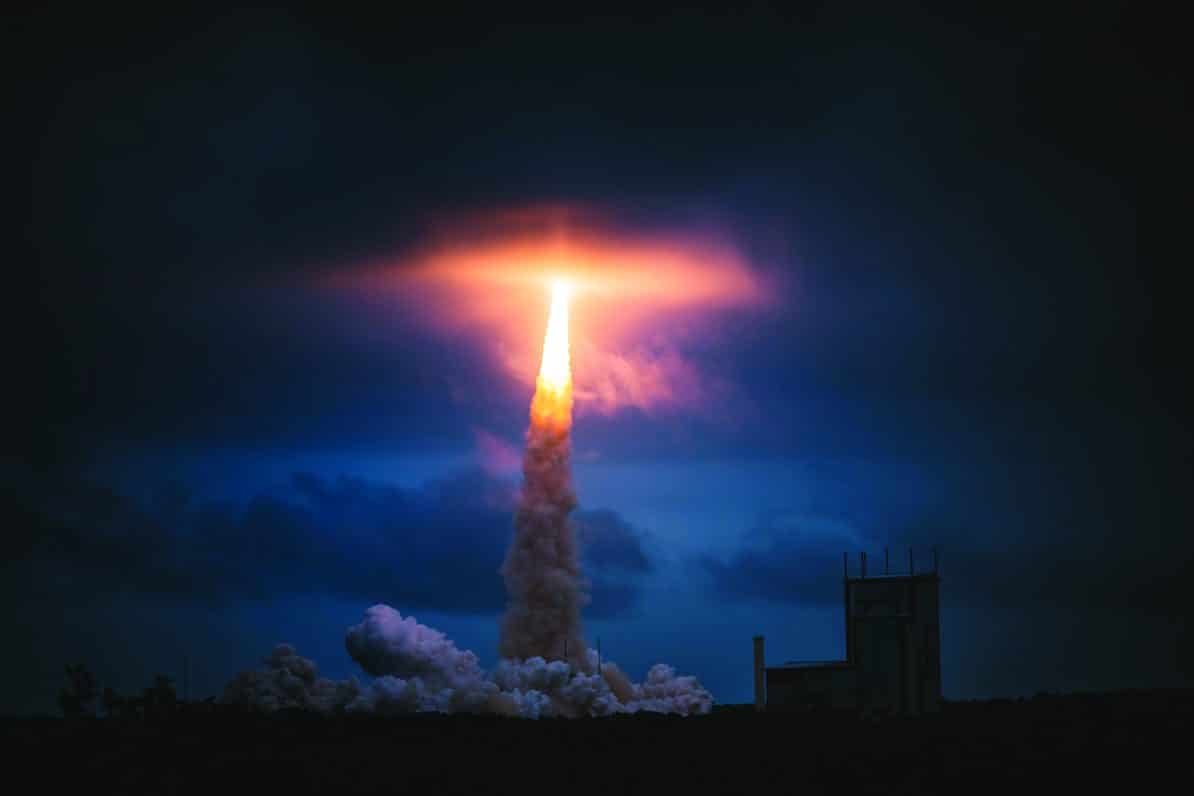
The James Webb space telescope is launched aboard the Ariane 5 rocket on Christmas Day 2021. Photo: Andrew Richard Hara / Getty Images
25th December 2021 (Taken from: #45)
The launch of the James Webb Space Telescope could be this generation’s giant leap for mankind. Taking almost 30 years and $10bn (£7.5bn) to develop, Webb (named after the former Nasa boss who headed the Apollo programme) has three main missions: to see the some of the earliest light from the beginning of the universe; to study the formation of galaxies and stars; and to look for signs of life around distant planets. To do this, Nasa has created a telescope 100 times more powerful than its predecessor, Hubble. It is the most ambitious project undertaken by the agency so far this century, and Mark Clampin, director of its Sciences and Exploration Directorate, remembers when it was just a doodle. “[French engineer] Pierre-Yves Bely drew a sketch of it in the mid-90s on a napkin,” says Clampin, who was working on the Hubble project at the time alongside Bely. “So James Webb has been around for a very long time.”
The telescope’s journey from serviette to space began in 2002 when US aerospace and defence multinational Northrop Grumman Space Technology was entrusted with developing Webb alongside Nasa. Clampin joined the project in 2003 and has been overseeing progress ever since, helping to navigate Webb through decades of technological trial and error, budget constraints, near-cancellation and a global pandemic. “Everything on this telescope takes time and you’ve got to be patient,” says the British-born astrophysicist. “It’s like a rollercoaster, if you don’t learn to navigate the bumps, you’re not going to get to the end.”
Clampin’s first job on Webb was as an observatory project scientist, working with engineers to ensure that all the scientific needs of the project were met. “On every project you have to do what’s called science trades: compromising on some of the engineering requirements because of practical or budgetary reasons,” he says. “The bigger the project, the more science trades you have to make. And they don’t come much bigger than James Webb.” The long-term nature of the project put Clampin and his team in an unusual position – making crucial decisions based on technology that could be years out of date by the time it came to launch. “As you go along you find things that you didn’t know because in Nasa missions we’re always pushing into the unknown,” he says. “But once you’ve made a decision, you’re stuck with it because to go back and undo it costs way too much money.”

Engineer Ernie Wright looks on as six of Webb’s primary mirror segments are prepped for cryogenic testing at Nasa’s Marshall Space Flight Center, April 2011. Photo: Nasa/MSFC/David Higginbotham
Webb is designed to capture the first light of the universe, produced by newly-formed stars and galaxies 13.5 billion years ago, not all of which has yet reached our point in the ever-expanding cosmos. It will effectively be looking back in time, observing stars that may not have existed for millions, even billions of years. This ancient starlight has long since moved into the infrared spectrum, meaning it’s now invisible to human eyes and undetectable to telescopes, including Hubble, that primarily operate in the visible spectrum. This is not a problem for the new telescope. “Webb is designed to work from basically the edge of the visible, [from a wavelength of] 0.7 microns, all the way out to 30 microns,” says Clampin. “This allows us to see what has never been seen before.” But operating in infrared raised some big questions for Clampin and his team. The first being: Where do you put the telescope? “The Hubble is in low-Earth orbit so it’s right next to this big, bright, warm Earth and it’s going from day to night,” says Clampin. “For Hubble that doesn’t impact the science, but for Webb it’s a game changer. You can’t do science with that kind of thermal change on an infrared telescope [because the heat of the Earth impacts the telescope’s readings]. So, rule one for Webb is that you have to go somewhere where you’re thermally stable, and ideally where you can operate 24/7, and that’s why we’ve gone to the second Lagrange point. It’s a great place to do science.”
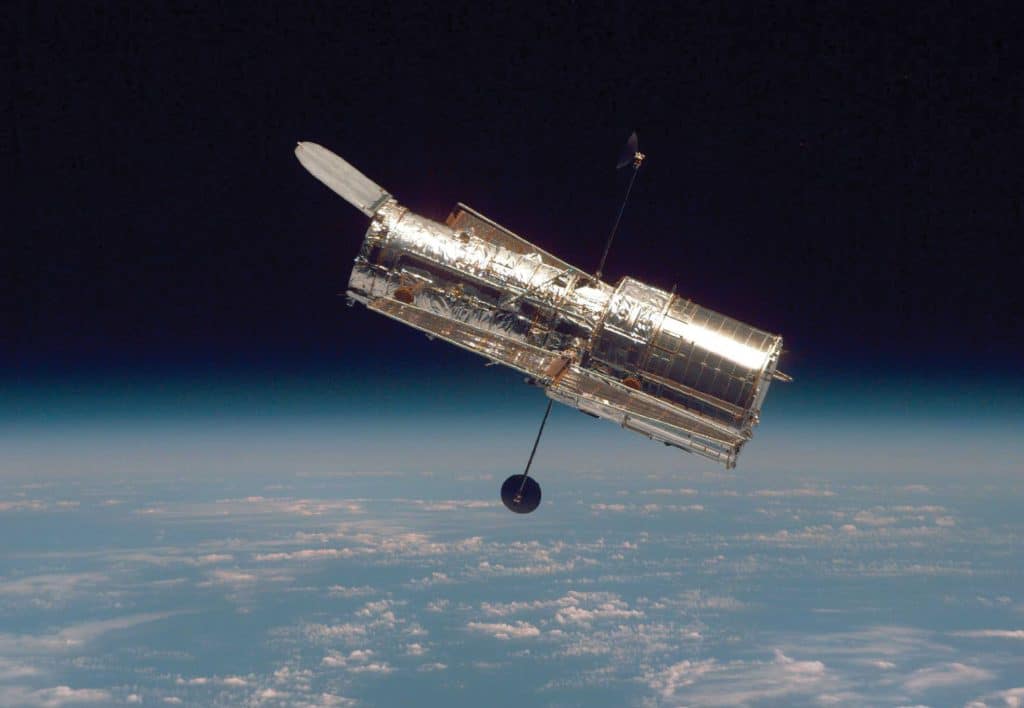
The Hubble Space Telescope orbits Earth in 1997; Webb will be 100 times more powerful than its predecessor. Photo: Nasa
It’s also a million miles away from Earth. So while Hubble could be serviced by astronauts if needed, Webb is very much on its own. Whatever the team created had to be both robust and remote controlled.
To capture the first light of the cosmos, Webb needed a mirror seven times bigger than Hubble’s, which threw up another problem: such a mirror would be too big to fit in any existing rocket. The engineers’ solution was to create a device that would fold up for launch and then unfurl once it got to space. It would contain 18 separate elements, made and installed with such precision that when combined they would form a gigantic mirror so powerful that if used from Earth it could detect the heat signature of a bumblebee on the moon. The total margin of error for aligning the segments is just 75 nanometres, the size of a bacterium. What’s more, every never-before-attempted, unrepairable, incredibly precise element would need to work at cryogenic temperatures.
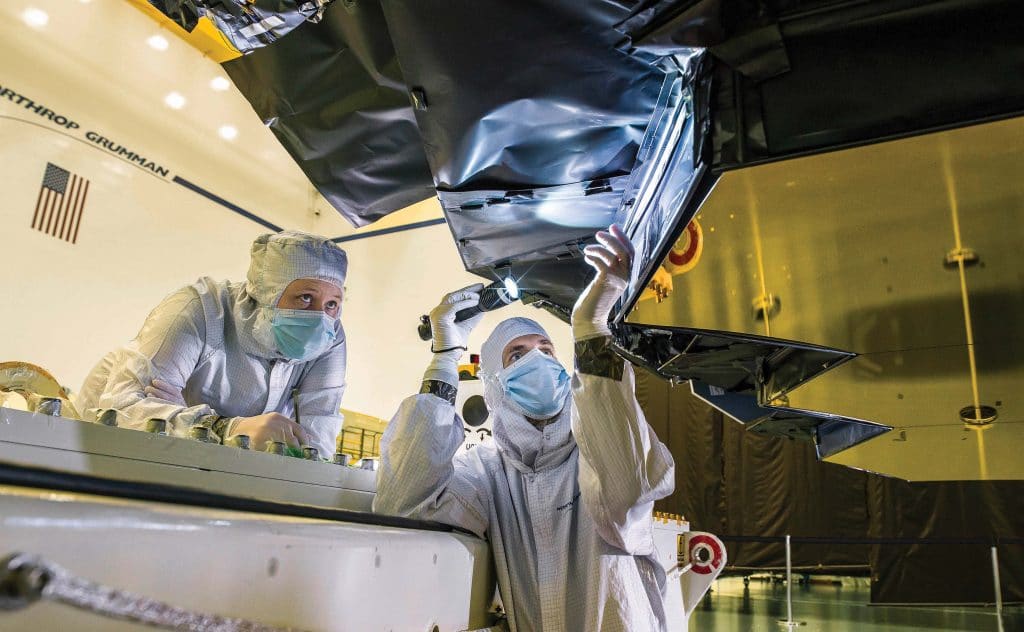
Blanket technician Ann Meyer and optical engineer Larkin Carey inspect the protective barrier behind Webb’s primary mirror, December 2018. Photo: Nasa
“If you’re trying to see the first galaxies in the universe via infrared you can’t be observing your own thermal signature,” says Clampin. “So, you have to get the temperature of the telescope lower than the objects you’re trying to observe, that’s a very big deal.” To ensure it would not glow brighter than the ancient starlight it’s looking for, Webb would need to operate at around -230°C (-380°F, 40 Kelvin). It was another thing for Clampin to add to his list of must-haves for the engineers. “As you can imagine, it was a very big document,” he says with a wry smile.
Another of the early decisions Clampin was involved in was what to build the mirrors out of. It came down to a choice between glass and beryllium, a metal six times stronger than steel but only about a third of the density of aluminium. “Glass is nice because it’s very easy to polish and you can make glass segments quickly, but the real question was how stable is it at low temperatures? Does the shape of the mirror change [so much] that your images are no longer sharp?” After conducting numerous tests, Clampin and his team decided that glass was too risky, and beryllium was chosen instead. “Beryllium is not a very nice material. It’s extremely unpleasant for humans in its powder form, but it is very stable,” he says. “You can change the temperature by a lot and the mirror doesn’t change. The downside is it takes a lot longer to polish beryllium, so each [of the 18] mirrors took three to four years to make.”
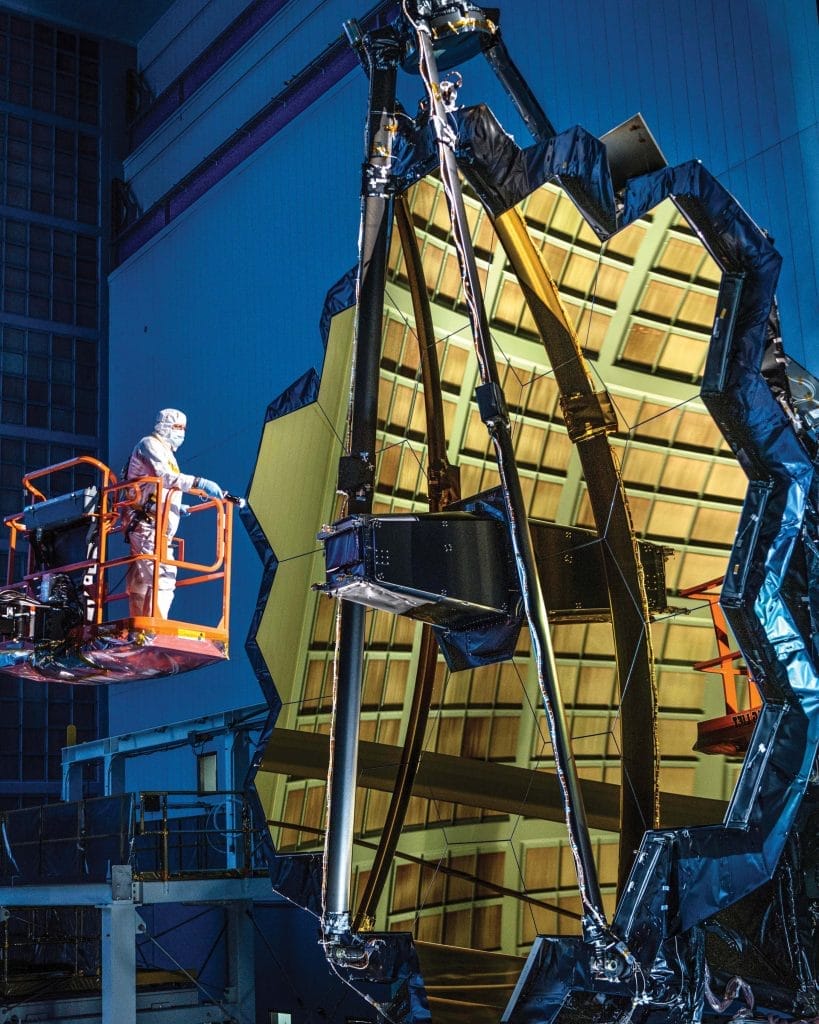
Technician George Mooney inspects a mirror on the James Webb telescope following a test, October 2016. Photo: Chris Gunn
But even with 1,460 days of buffing, beryllium doesn’t reflect infrared light well enough to direct it to Webb’s two cameras and two spectrographs – which separate light by its wavelengths and record the data. “Beryllium’s very grey and it’s not very reflective in the infrared, so for every 100 photons that hit the mirror, you’d lose 30 of them,” says Clampin. “So the mirrors are coated with a very fine layer of gold just to make sure that, having invested all this money, we’re getting the best value. The gold is around 98 percent reflective in the infrared, so we collect nearly all the light that hits the mirror.”
Next on Clampin’s problem list was the sun: even at a million miles from Earth, direct sunlight would raise the heat of the telescope to inoperable levels – yet the rays were essential to power the instruments on board. “In the past we’ve flown infrared telescopes with a big cooler of liquid helium and that keeps them cold,” says Clampin. “But the problem is, after a couple of years it boils off and then you have a warm telescope. So we went with a very different approach, which is passive cooling. The Webb has this tennis-court-sized sun shield that allows the telescope side of the observatory to get really cold while the other side faces the sun and collects power from the solar rays.”

Webb is placed in Johnson Space Center’s historic Chamber A to prepare for final testing in a cryogenic vacuum that mimics temperatures in space. Photo: Nasa/Chris Gunn
The giant sunblock is made of five layers of reflective fabric, each as thin as a human hair. Like the foldable mirror, the shield needed to be deployed and controlled in space, something that had never been attempted on such a scale before. Watching the device being fully extended for the first time is one of Clampin’s abiding memories of the project. “It was just very surreal,” he says. “We were in a clean room in Northrop Grumman [headquarters]. All the motors were running and this thing was starting to tighten up. Because it’s so big it takes a long time, so you’re standing there for almost half an hour watching it shimmering and then it starts moving. It was very, very weird to see this incredible thing take shape.”
In total it took an estimated 100 million hours to create the James Webb space telescope, with more than 3,000 scientists, engineers and technicians from 14 countries contributing to the project. Most of the work took place at the Goddard Space Flight Center in Maryland before Webb was sent to the Johnson Space Center in Houston, Texas for further testing. Both centres are equipped with massive thermal vacuum chambers to expose the telescope to the extreme cold.
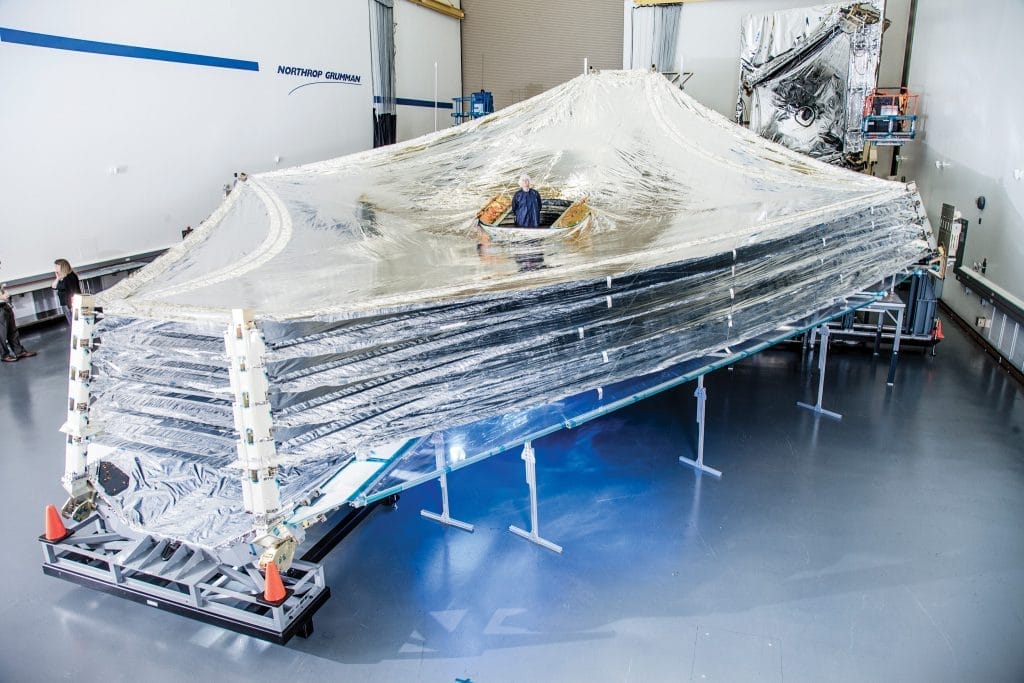
Mark Clampin standing in a full-scale test article of the sunshield on the Webb telescope, 22nd July 2014. Photo: Nasa/Chris Gunn
Cleanliness was essential. Clampin says that dust and volatiles were of particular concern. “Any particulates on the mirror will reduce the amount of light it can reflect back to the instruments and scatter light,” he says. “So we go to extreme lengths to keep the dust out.” The other contamination concern, volatiles, are the chemicals released by materials when they’re in a vacuum or exposed to extreme temperatures. “One of the challenges with infrared telescopes is ensuring you don’t find yourself in a position where the coldest thing around is the mirrors because when water is released from a carbon fibre structure due to temperature changes, the last thing you want is for it to then stick to the mirrors.”
The cold – and risk of volatiles – meant that every piece of equipment on board had to be insulated. “Everything’s gift-wrapped in multiple layers of insulation,” says Clampin. “So you need to be very thorough with your testing from the start. You don’t want to get to the end of the programme and find out you didn’t connect one of your instruments properly.” The testing process began in 2015, six years before James Webb was launched into space.
Having been built and tested in the US, Webb was to travel to space on the European Space Agency’s Ariane 5 rocket, launched from the French Guiana Space Center. Clampin was on troubleshooting duties. “I went down there in 2006 to figure out what would be required if we flew the telescope in and then transported it on a truck from the airport at Cayenne to the launchpad at Kourou. Were the bridges big enough? Were there structures we’d have to move? It turns out we’d have had to make some major infrastructure changes in French Guiana to get it in by road, so we went with a boat.” Webb travelled from California, through the Panama Canal, aboard the MN Colibri, arriving in French Guiana on 12th October 2021 ahead of a Christmas Day blast-off.

Webb’s ground support equipment being fitted for thermal testing of the instrument complement at the Goddard Space Flight Center, May 2012. Photo: Nasa/Chris Gunn
Having been involved in Webb for the best part of 18 years, Clampin was prevented from seeing it take off in the flesh by something even he couldn’t foresee. “We had cut back on the number of people who could go down for the launch because of the pandemic,” he says, although he counts himself as fortunate to be among the handful of scientists and technicians who got to watch it from the Space Telescope Science Institute in Maryland. “Most of the people involved in the program were watching the launch from home.”

Thermal coatings engineer Nithin Abraham prepares the thermal-vacuum test facility at Nasa’s Johnson Space Center in Houston, Texas. Photo: Nasa/Chris Gunn
In the room there was a palpable sense of apprehension. “It’s very tense until you actually see it’s off the pad. Then you can breathe out,” says Clampin. Things went more smoothly than anyone had dared to hope. “We actually got to see the first deployment – that stage where the spacecraft separates from the launch vehicle. You don’t usually see deployments, just numbers on a screen, so it was really impressive just watching each of these systems perform as we planned and working as it was designed,” says Clampin. “That was a real Christmas present.” Even after the perfect launch, James Webb still had a long way to go. The unfolding of the giant mirror took two weeks alone. Its final position wasn’t reached until a month after launch and the focusing process is unlikely to be completed before mid-summer. While Clampin is interested in Webb’s mission to see first light, what really excites him is learning more about exoplanets and he will get to use the telescope to explore one in particular. “Because we collect so much more light with that massive mirror, we can actually start to talk about doing atmospheric studies of exoplanets,” he says. “I have a programme to study one of these objects called TRAPPIST1e, a planet just on the edge of a habitable zone, which is the region where water could exist on a planet orbiting a star. So that’s going to be really exciting when we get to do that.” Again, he’ll have to be patient. “Sometime over the next 18 months we’ll start getting those observations.”

Engineer Erin Wilson adds aluminium tape to electrical cables to protect them from the cold, May 2012. Photo: NASA/Chris Gunn
While he waits, Clampin has plenty of time to consider the question he gets asked the most. “People always ask me, ‘What’s the point of doing these gigantic programmes?’ And I think that’s a very important question,” he says. He cites several factors that justify the costs including advances in everyday technology. “Hubble made a big investment in charge-coupled devices, which are in every iPhone now.” The project will also inspire interest in science in a new generation. “Watching Neil Armstrong walk on the Moon inspired me to become a scientist, and hopefully the images from James Webb will have their own impact.” Ultimately, however, it comes down to discovery. “Hubble has rewritten the astrophysics textbooks several times over – imagine what Webb will do!” Clampin enthuses. “We’re going to discover new things that we didn’t even know were out there to be discovered.”
Slow Journalism in your inbox, plus infographics, offers and more: sign up for the free DG newsletter. Sign me up
Thanks for signing up.

